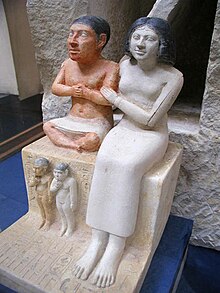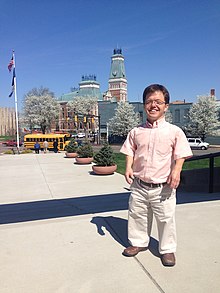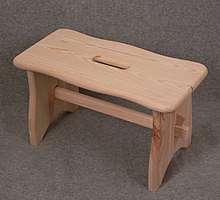Short stature

Short stature , short stature or microsomia in humans is a term for a non-standard, shorter body length growth that can be caused by a variety of congenital or acquired growth disorders .
About 100,000 small people live in Germany.
designation
A significantly below average growth in length is referred to in medicine as short stature . The former medical term "short stature" is no longer used due to the negative connotation. Designations such as “dwarf” or “midget”, which are sometimes used colloquially, even though most of those affected perceive them as discriminatory, also have negative connotations.
definition
In adults, short stature means a height of less than 150 cm. Extreme short stature (formerly known as dwarfism or nanosomia ) leads to a height of less than 130 cm in adulthood. This definition can vary slightly from country to country.
In the medical sense, children are short stature when their height falls below the third percentile of the growth curve for the corresponding age or falls below the mean value by more than two standard deviations , i.e. only 3% of their peers are shorter. In most cases, however, this short stature has no disease value, because even healthy children can fall below these limits. The child's development over time is therefore more important than the absolute value. Its growth development should follow the percentiles and not cross them down.
causes
About 450 different types of short stature are known and the possible causes of short stature are very diverse.
| Classification according to ICD-10 | |
|---|---|
| E34.3 | Short stature, not elsewhere classified |
| ICD-10 online (WHO version 2019) | |
Some forms of short stature exist before birth (primary short stature), such as skeletal dysplasias or insufficient supply during pregnancy. Other forms of short stature arise later (secondary short stature), for example growth hormone deficiency or chronic diseases.
In the context of diagnostics, however, a distinction is made between whether the growth is proportioned or disproportionate, i.e. with a relationship between head, trunk and extremities that deviates from the norm.
Norm variants (not pathological)
- Family stature :
In the case of familial short stature, the parents of the person concerned are also short, and the final height of the child is in the range that can be expected based on the size of the parents. There are also ethnic groups in which the average height of men is less than 150 cm, which means that they are naturally short.
- Constitutional Developmental Delay :
The constitutional delay in development results in a delayed development of bone maturity and a delayed onset of puberty. In many cases it occurs in families. Boys are affected twice as often as girls. In these cases a normal height can be achieved, only with a delay.
Pathological forms
- Intrauterine stature :
Those affected are very small at birth, which is due to various factors during pregnancy. Most children can catch up with the stunted growth, but some remain short.
- Chromosomal disorders with aneuploidy (extra chromosomes) :
In the context of Ullrich-Turner syndrome , in which those affected only have one functioning sex chromosome (X), short stature is just one of many characteristics. People with Down syndrome are sometimes short too .
- Syndromic diseases :
Syndromes such as Noonan's syndrome , Silver-Russell syndrome or Prader-Willi syndrome are complex clinical pictures in which short stature is just one symptom among many others.
- Skeletal Dysplasia :
Skeletal dysplasia is a general disorder of cartilage or bone growth. There are a variety of skeletal dysplasias, most of which are associated with disproportionate short stature. The most common skeletal dysplasia and also the most common pathological form of short stature is achondroplasia . Other examples are spondyloepiphyseal dysplasia and diastrophic dysplasia .
- Malnutrition :
Malnutrition can slow down growth in children.
- Organic causes :
Growth retardation can be caused by chronic diseases such as heart or liver disease.
- Endocrine disorders :
Some growth disorders are due to hormonal disorders such as a lack of growth hormone , diabetes mellitus or an underactive thyroid . These disorders are usually easy to treat, so that affected children can achieve a final height in the normal range.
- Metabolic disorders :
In phosphate diabetes , the body excretes too much phosphate, which impairs bone growth and causes disproportionate short stature. Other metabolic disorders, for example disorders of protein metabolism or fat metabolism , can also cause short stature.
- Psychosocial causes :
Short stature can also have psychosocial causes. Mention should be made here of psychosocial deprivation and depression .
- Iatrogenic causes (medical treatments) :
Medical therapies that put a lot of strain on the body can also be a cause of short stature: radiation therapy , chemotherapy or high-dose glucocorticoid therapy.
Barriers and resources
In everyday life, short people are confronted with many barriers, since the environment is geared towards people of average height. For example, ATMs, kitchens, toilets and sinks can only be used by many short people with aids. Low stools and steps play a special role here, as they can be used in many ways to bridge the height gap.
Stools are also helpful as footstools when sitting, because when sitting on an average chair, the legs of short people dangle in the air, which is painful and uncomfortable in the long run and can also impair fine motor skills when working. Specially adapted therapy chairs are therefore also used as aids in school or at work.
In order to be mobile, some small children and also adults resort to specially adapted scooters or bicycles, because depending on the type of short stature, walking long distances can cause problems.
With appropriately retrofitted vehicles, most of the short stature can drive a car without restriction. As a rule, at least one pedal extension and an individually adapted seat are required .
Sports
Regular exercise can help prevent back and joint problems, which are particularly common in skeletal dysplasias. The joy of movement and the sporting ambition of small children is often limited early on by the fact that they are measured by the same standards as non-disabled people and quickly reach their limits. Depending on the short stature, there are restrictions in particular for apparatus gymnastics, running sports, jumping sports and ball sports.
In general, however, there is no sport that can be ruled out for small people. According to a non-representative survey by the BKMF eV (Bundesverband Kleinwüchsige Menschen und their Families) in 2008, the most popular sports are swimming (42% of those surveyed), football (20%), cycling (10%), fitness training (8.2%) , Riding (6.7%), karate (5%) and dancing (5%), whereby only 8% of all respondents practice the respective sport in a disabled sports club.
Small people are also represented in competitive sports. In Germany they are organized in the German Disabled Sports Association. The Paralympic Games have their own impairment category for children of stature. Successful small Paralympians include Niko Kappel , Mathias Mester and Tiffany Thomas Kane .
The World Dwarf Games have been held every four years since 1993 and are organized by the International Dwarf Sports Federation and in which small athletes from all over the world can take part. 420 athletes from 20 different countries took part in the World Dwarf Games 2017 in Guelph (Canada). The games are to take place in Germany in 2021.
See also
- Short people in ancient Egypt
- Pygmies
- Court dwarf
- Dwarfism as an evolutionary phenomenon (nanism)
- Dwarf throwing (human rights judgment, professional ban)
- Shrink Germans
literature
- S1 guideline for short stature of the German Society for Endocrinology and the German Society for Child and Adolescent Medicine (DGKJ). In: AWMF online (as of 2016)
- Betty M. Adelson: Dwarfism: Medical and Psychosocial Aspects of Profound Short Stature. Johns Hopkins University Press, 2005, ISBN 0-8018-8122-6 , pp. 50-54.
Web links
Individual evidence
- ^ Hans Bankl, Walter Ulrich: Workbook Pathology . Facultas-Univ.-Verlag, 2002, ISBN 978-3-85076-492-6 , pp. 58 .
- ↑ Ludger Dorlöchter, M. Radke: Pediatrics in a nutshell . Walter de Gruyter, 1999, ISBN 978-3-11-015552-5 , p. 321 ( google.com ).
- ^ Klaus Buckup: Pediatric Orthopedics . Georg Thieme Verlag, 2001, ISBN 978-3-13-697602-9 , pp. 58-9.
- ^ Gustav-Adolf von Harnack, Berthold Koletzko: Pediatric and Adolescent Medicine: with 154 tables; [now with case quiz] . Springer-Medizin-Verl., Heidelberg 2007, ISBN 978-3-540-48632-9 .
- ^ Constitutional Growth Delay and Familial Short Stature: A Guide for Families. In: Pediatric Endocrine Society. American Academy of Pediatrics / Pediatric Endocrine Society, 2018, accessed July 13, 2019 .
- ↑ G. Binder, J. Wölfle: S1 guideline - small stature. German Society for Children's Endocrinology and Diabetology eV, December 2016, accessed on July 13, 2019 .
- ↑ BKMF (Ed.): Help for the everyday life of small people . Bremen December 2006, p. 22, 30, 37 .
- ↑ BKMF (Ed.): Help for the everyday life of small people . Bremen December 2006, p. 56-59 .
- ↑ BKMF (ed.): I like to do sports - people of short stature on the move . Bremen May 2010, p. 6-7, 47-48 .
- ↑ BKMF (ed.): I like to do sports - people of short stature on the move . Bremen May 2010, p. 32-33 .
- ↑ Event History. In: World Dwarf Games 2017. 2017, accessed on July 13, 2019 .
- ^ World Dwarf Games. IDSF, 2019, accessed July 13, 2019 .

